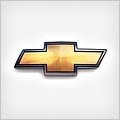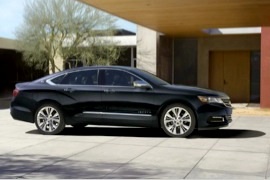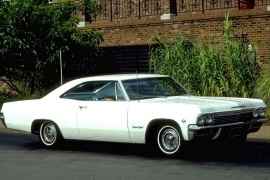
CHEVROLET Impala
Generations Timeline, Specs and Pictures

Chevrolet introduced the tenth generation of the Impala in 2013 as a 2014 model-year on the same platform as the Cadillac XTS and the Buick LaCrosse.
After parting with Opel and Saab, GM kept the Epsilon II platform in both versions with a short or long wheelbase. It was designed in Germany for front-wheel-drive vehicles and adapted in Sweden to support all-wheel-drive ones. Its most extended form complied with GM demands for a pre-premium car.
Chevrolet insisted on a fastback-like bodywork, similar to the one from the Opel/Vauxhall Insignia. Its sculptured side panels and the arched line over the rear wheels emphasized a sport-sedan image since it played in the big-car league against Honda Accord or Toyota Camry. Its headlights came fitted as standard with HID lamps and LED daytime running lights for selected trim levels.
Inside, the design team benefited from the long wheelbase and installed thick bucket seats at the front and a comfortable bench profiled for two full-grown adults in the back. The tall center tunnel made life difficult for a third passenger, and the carmaker didn’t even bother to install a third headrest. While the base trim-levels sported cloth seats, on the upper versions, the interior was leather-wrapped.
Under the hood, Chevrolet offered the Impala with a choice of four engines, including a hybrid version. The carmaker offered the car with a standard six-speed automatic transmission for the entire range.

I’m pretty sure that the nameplate of Impala takes you back in the late 50’s, when the first generation was released.
Or back to the second generation that was easily recognisable for its bat-wing rear end, and the teardrop-like brake lights.
For 2006, the Impala was completely redesigned for a more modern and sportier look.
The Impala was offered in three trim levels: LS, LT and LTZ. The standard equipment was already well supplied.
The interior of the Impala was large and pleasant and could accommodate up to 6 people.
The instrumentation was simple and very intuitive. The control knobs were easy to use while driving as they were big enough to allow the driver not to take their eyes off the road.
The radio controls were duplicated on the steering wheel.
Power windows and door lock were standard across all trim levels.
The materials used for the cabin were of high quality.
The trunk offered a good load area and could be extended by lowering the rear seats with the 60/40 configuration on the LTZ and the SS models.
Three engines were available for the 2006 model, and while the V6s were nothing new to the Impala, a V8 5.3-liter engine developing 303 hp returned to the lineup for the Impala SS.

We’re sure you’re familiar with the Impala nameplate and the 60’s Impala’s muscular lines come to your mind.
Many say that the 2004 Impala was just a marketing strategy, but was it?
Well… the new Impala was definitely fast. As fast as the 90s’ Impala. Driven by a 3.8-liter pusher V6 engine that developed 240 hp and 280 lb.-ft of torque, mated with a Hydra-Matic 4T65-E 4-speed automatic transmission, the sedan was great for touring, providing smooth shifts and a quick kick-down reaction.
However, the power was sent to the front wheels, while the Impala used to suggest a rear-wheel-drive only vehicle.
Aesthetically, the 2004 Impala could easily get lost in the crowd, with a rather dull exterior design. The sedan was only available in a monochromatic black exterior and featured a rear spoiler, side folding and 17-inch alloys.
Inside, everything was well laid out with all controls easily deciphered and easy to use. The generous panel of instrument included both boost and oil temperature.
Space-wise, the Impala was very roomy with a bench installed in the rear cabin. The passengers enjoyed great headroom and legroom.
The trunk was a good size as well, offering 526 liters of storage.
Standard features coming with the Impala were power windows, door locks and mirrors.

Although the original Impala was dropped in 1996, Chevrolet decided to revamp the model in 2000 in order to replace the mid-size Lumina.
The new Impala was exclusively manufactured by the Oshawa Car Assembly in Ontario, Canada and, for the first time in its history, it featured a front-wheel drive system. In addition, Impala offered two engine configurations, both V6 but with different displacements: 3343 and 3791 cmc, respectively. The 1999 Impala was entirely developed on the GM W platform, similar to Buick Regal, Pontiac Grand Prix, Chevrolet Monte Carlo and Oldsmobile Intrigue.

In the 1960s the Impala was America’s best selling car, the Impala could be a family car, a people carrier, and a big-block V8 super sport rocket.
The clean athletic shape of the ‘66 Impala represented GM’s experience in a era where style really mattered. The SS Coupe was available as a hardtop coupe as well as a convertible, it featured an all-vinyl bucket seats interior, center console and distinctive SS touches.
The impressive Super Sport coupe came with a V8 turbo-jet engine that produced 390 horsepower, and a four speed manual transmission, auxiliary gauge package and Positraction.

Chevrolet introduced the fourth generation of the Impala in 1965, in the middle of the muscle-car era, and prepared a Super Sport version for it, which came a year later.
With all the pony-cars and sports cars, and muscle cars around, it was hard for a carmaker to launch a new coupe on the market. Yet, Chevrolet dared to offer the Impala with a Super Sport package, and it was close to competing with its own Chevelle or Malibu, both being offered with a Super Sport package. But the Impala was more of a personal coupe than a muscle car.
While its four-door sedan broke all the sales records and passed the one-million cars sold in twelve months, the Impala Super Sport was the kind of vehicle sold for those who couldn’t go to the drag-strip, but they wanted to. It was large, with two doors and with room for six. Moreover, in the open-top version, it looked even better. Its chromed grille at the front and dual headlights system looked impressive but not intimidating.
Inside, the SS model was available with a wood-trimmed steering wheel, a heating and air-conditioning unit, and a radio. Its bucket seats at the front were too flat to be called that way, but that’s how Chevrolet named them on the options list. The carmaker provided a tilt and telescopic steering wheel, but only depending on the trim level and options.
The Super Sport version featured a four-speed manual transmission with an option for a two-speed automatic. Later on, Chevrolet introduced a three-speed automatic for the Super Sport. Under the hood, the carmaker installed a seven-liter V-8 engine that produced 390 hp. That was enough for a muscle car, but the Impala, with its almost 4,000 lbs (1,800 kg) weight, was too heavy. Not to mention that it wasn’t available with disc brakes.























































